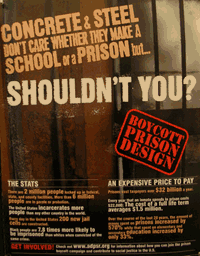In the late 1980s and early 1990s, as France embarked on a massive prison-building campaign, working class anarchist revolutionaries fought back by attacking the prison-industrial complex. Naming themselves Os Cangaceiros after the social bandits of the Brazilian northeast in the late 19th and early 20th Centuries, the revolutionaries sabotaged prison construction, published prison blueprints, and physically assaulted architects who designed prisons before being repressed and melting away into the subterranean criminal networks they had established over the previous decades.
Professionals are responsible for their behavior, the revolutionaries argued. In a communique to one prison architect they attacked, they wrote:
Letter to an Architect
Subject: Ambush
Are your wounds well healed, architect? Did you figure out why?
Shamelessly, with no discretion of any kind, centimetre by centimetre, you have conceived these cages in which even the handicapped will be locked up. Inside the walls which you have designed, individuals who are worth more than you will be beaten up on a regular basis. It is good that you have received an appetizer of what thousands of prisoners will endure to the nth degree.
To be sure, architect, this is not your company's first infamy. Considering what you build to house normal citizens, one can guess your competence to shut away delinquents. One moves easily from the tower blocks of the 13th arrondisement to prison cells.
Pig, looking at your snout up close, we were able to note from your tired face how deeply you involve yourself in your projects.
Before you were building walls, now you're going to knock them down.
Os Cangaceiros, Lyon, 29/03/90
Beginning in the 1980s, the US has seen an ever more massive prison boom and a never-ending demand for more prison construction. With the prison and jail population now approaching 2.3 million and steadily increasing, there is no end in sight. And as in France, architects are among those profiting from penal profligacy. But not all members of the profession are willing to "conceive cages."
Architects/Designers/Planners for Social Responsibility (ADPSR) is not a revolutionary anarchist organization, but, as the name suggests, a group of architects and planners interested in social justice issues. Still, ADPSR shares with Os Cangaceiros both the belief that professionals have an obligation to help create a better society and the conviction that mass imprisonment as a solution to social problems is something to be decried, not abetted.

Between September 2004, when the campaign started, and January 2006, 500 of the estimated 1,000 to 2,000 architectural and planning professionals who would work on prison design signed the pledge. Now, according to campaign head Raphael Sperry, a San Francisco Bay-area architect, that number is up to 800.
For Sperry and ADPSR, the prison design boycott is part of a larger effort to challenge militarism and violence within American society and the US government. "We have a long history of peace and social justice work dating back to the 1980s," Sperry told Drug War Chronicle. "This campaign had its genesis in the war with Iraq. For us, the war presented us with the issue of militarism, both at home and abroad. With the peace movement so far ineffective, it seemed important to us to challenge this whole mindset at home, where people can see it on a day to day basis, and prisons are one of the biggest social justice failings of our country these days," he said.
"We are calling for an end to the expansion of the prison-industrial complex as a first step," Sperry continued. "We also want to see reinvestment in communities to provide for public safety and we want community-based alternatives to incarceration to solve problems and reduce crime."
ADPSR specifically targets the war on drugs. "The war on drugs is one of the biggest components of the rise of mass incarceration, and the drug laws and drug policy is one of the biggest problems in our criminal justice system today," Sperry said. "We use incarceration instead of treatment. That's not solving the problem, just pushing it behind the walls."

"We have gotten a lot of attention from architects who design prisons," said Sperry. "Even many of them share and appreciate our understanding of the flaws of the criminal justice system. Raising awareness is really important because it can provide us with real room for legislative reform on criminal justice issues like sentencing and drug policy. With this campaign, we hope to add another noisy voice to those already calling for reform."
With about one-third of planners working for various government agencies, reaching them with the campaign message is a tactical goal. "These are the people who put together future prison population projections and do the planning used to create mass incarceration. Every year, they just say "we're going to need more prisons," instead of arguing for policy decisions to reduce the number of prisoner," Sperry noted.
It's not just architects and planners who have embraced the Prison Design Boycott. It has been endorsed by a number of criminal justice reform groups, including the anti-prison activists of Critical Resistance, the Justice Policy Institute, which seeks to end over-reliance on incarceration, and the November Coalition, which focuses on drug war prisoners.
"We embraced the architects' efforts early on because we agree with them that there are too many people in prison and it's essential to expand our movement," said the November Coalition's Tom Murlowski. "Architects and planners are part of the infrastructure of the prison-industrial complex, and we are very pleased to see this organization challenge the profession on this," he told the Chronicle.

While the campaign may not prevent prisons from being built, the project will advance the cause in various ways, said Sperry. "Look, if 99% of architects signed the pledge, there would still be that 1% willing to do the work, but at the level of political acceptability, if we reach a point where a majority of architects are saying the government shouldn't even embark on building new prisons, that says something. Architects are licensed by the state and have a responsibility to protect the public health, safety, and welfare, so if they are saying building prisons does not contribute to a safe public environment, that's a strong public statement," he said.
"There are a lot of young architects who say they didn't become architects to lock people up," Sperry concluded. "I hear stories of the partners in firms going after those contracts, but the young people didn't want to work on prisons. There was an internal resistance, but not a coordinated movement, so we thought we could make a public statement and make it more targeted."
The campaign pledge is not just for architecture, design, and planning professionals. Sperry and the Prison Design Boycott Campaign want anyone who understands and agrees with their position to sign the pledge on their web site.
While the methods of Os Cangaceiros may have a certain outlaw appeal, we're happy to see the architects themselves trying to take matters in hand instead.
This work by StoptheDrugWar.org is licensed under Creative Commons Attribution-ShareAlike 4.0 International
Comments
Finally someone's making sense
It's about time you figure out that prison does nothing to our society but bring our citizens into slavery.
You profit off of someone else's mistakes (or sins).
It's not enough to give a poor person fines that they cannot afford in a life time of working at poverty level, but you dig deeper into the wounds of a drug addict (an illness not a crime) to make them slave away to line the pockets of the lawmakers who make draconian sentencing or punishment from outlandish laws against our unalienable rights.
You oppress the poor and crush the needy...you are the (fat cows on Capitol Hill) and you will be surprised that the Word of God speaks out against you, too! (Amos 4:1)
America's Prisons
This type of activism against the "war on crime" or "war on drugs" or actually, "war on the Constitution," is long overdue. For years now, the U.S. has been number one in the world for the percentage of citizens we have behind bars (including countries such as Iran, Afghanistan, Turkey, China, Russia, and other similar "repressive" regimes.) Obviously, our government leaders/politicians have placed us in this position; many are profiting from these wars, such that we cannot rely on members of Congress (or state legislators) to stand up and say, "Enough is enough" and speak out against these unconscionable and ineffective measures. They are too available to the profiteers, from whom too many of these politicians in turn profit, to expect them to turn around these misbegotten policies. I really preferred LBJ's "war on poverty." Did we win that one?
A Prison Alternative Idea Who's Time Has Come
Check out gracetowne.blogspot.com
Add new comment